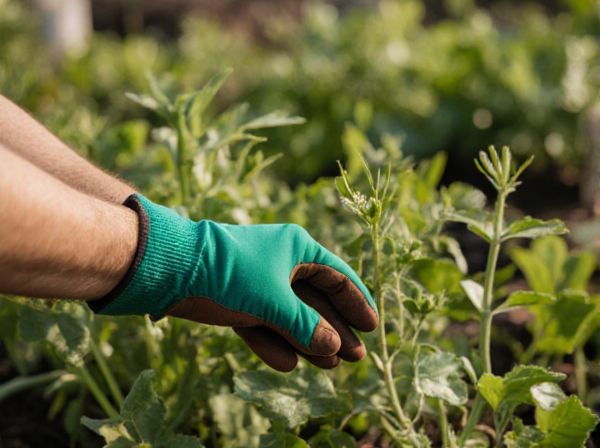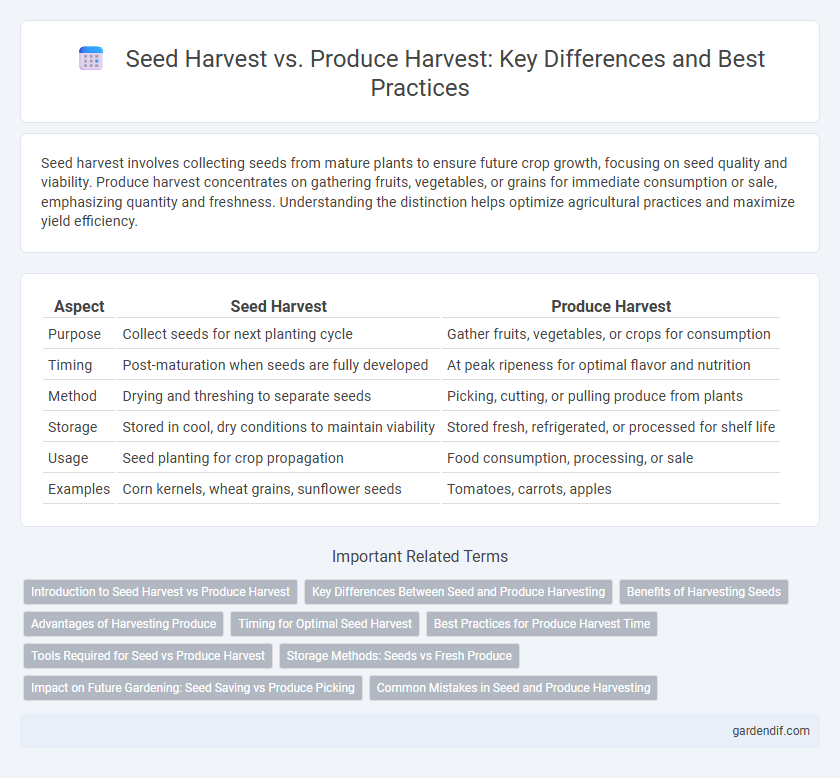
Seed Harvest vs Produce Harvest Illustration
Seed harvest involves collecting seeds from mature plants to ensure future crop growth, focusing on seed quality and viability. Produce harvest concentrates on gathering fruits, vegetables, or grains for immediate consumption or sale, emphasizing quantity and freshness. Understanding the distinction helps optimize agricultural practices and maximize yield efficiency.
Table of Comparison
| Aspect | Seed Harvest | Produce Harvest |
|---|---|---|
| Purpose | Collect seeds for next planting cycle | Gather fruits, vegetables, or crops for consumption |
| Timing | Post-maturation when seeds are fully developed | At peak ripeness for optimal flavor and nutrition |
| Method | Drying and threshing to separate seeds | Picking, cutting, or pulling produce from plants |
| Storage | Stored in cool, dry conditions to maintain viability | Stored fresh, refrigerated, or processed for shelf life |
| Usage | Seed planting for crop propagation | Food consumption, processing, or sale |
| Examples | Corn kernels, wheat grains, sunflower seeds | Tomatoes, carrots, apples |
Introduction to Seed Harvest vs Produce Harvest
Seed harvest involves collecting mature seeds from plants specifically grown for reproduction, ensuring genetic purity and viability for the next planting cycle. Produce harvest focuses on gathering fruits, vegetables, or grains at peak ripeness intended for immediate consumption or market sale. Understanding the distinction between seed harvest and produce harvest is essential for optimizing agricultural practices and crop management strategies.
Key Differences Between Seed and Produce Harvesting
Seed harvest focuses on collecting mature seeds from crops such as grains, legumes, and oilseeds for future planting or processing, emphasizing seed viability and purity. Produce harvest targets the collection of fruits, vegetables, and other edible crop parts, prioritizing freshness, nutrient content, and market readiness. Key differences include the timing of harvest, with seed harvesting occurring at full seed maturity, while produce harvesting often happens earlier to ensure quality and shelf life.
Benefits of Harvesting Seeds
Harvesting seeds preserves genetic diversity crucial for crop resilience and future planting cycles. Seeds provide a renewable resource that farmers can store, select, and breed to improve crop yields and resistance to pests and diseases. Unlike produce harvest, seed harvesting enables sustainable agriculture by ensuring long-term food security and adapting crops to changing environmental conditions.
Advantages of Harvesting Produce
Harvesting produce allows immediate utilization and market distribution, maximizing freshness and nutritional value compared to seed harvest. It reduces post-harvest processing costs and enhances economic returns by supplying directly consumable goods. Produce harvest also supports diverse crop management strategies, improving overall farm productivity and sustainability.
Timing for Optimal Seed Harvest
Timing for optimal seed harvest is crucial to maximize germination rates and seed viability, typically occurring when seeds reach physiological maturity but before they naturally disperse. Seed harvest generally happens later than produce harvest, as seeds require full development and drydown on the plant to ensure proper dormancy and longevity. Harvesting too early results in immature seeds with poor storage potential, while delayed seed collection can lead to loss through shattering or pest damage.
Best Practices for Produce Harvest Time
Optimal produce harvest time relies on monitoring sugar content, firmness, and color indicators to ensure peak freshness and flavor. Implementing regular field assessments and using tools like refractometers can help determine the best harvest windows for different crops. Proper timing reduces post-harvest losses and maximizes nutritional value, contributing to higher market quality and profitability.
Tools Required for Seed vs Produce Harvest
Seed harvest typically requires precision tools such as seed threshers, seed cleaners, and drying equipment to ensure the viability and purity of seeds. Produce harvest, on the other hand, involves tools like sickles, harvesters, and crates designed for efficient collection and minimal damage to fruits and vegetables. Specialized equipment enhances the quality and efficiency of both seed and produce harvesting processes.
Storage Methods: Seeds vs Fresh Produce
Seeds require dry, cool storage conditions with low humidity to maintain viability and prevent mold growth, often stored in airtight containers or seed banks. Fresh produce demands refrigeration or controlled atmosphere storage with precise temperature and humidity levels to preserve freshness and slow down respiration and microbial decay. Proper differentiation in storage methods is critical for prolonging seed dormancy versus maintaining produce edibility and nutrient content.
Impact on Future Gardening: Seed Saving vs Produce Picking
Seed harvest plays a crucial role in future gardening by enabling seed saving, which preserves genetic diversity and ensures plant resilience across growing seasons. Produce harvest focuses on collecting mature fruits and vegetables for immediate consumption, limiting seed availability for the next cycle. Prioritizing seed saving during harvest supports sustainable gardening practices and fosters long-term crop improvement through selective breeding.
Common Mistakes in Seed and Produce Harvesting
Common mistakes in seed harvest include harvesting seeds too early before full maturity, resulting in low viability and poor germination rates. In produce harvest, errors often involve picking fruits or vegetables either prematurely or too late, leading to reduced flavor, texture, and shelf life. Proper timing based on crop-specific maturity indicators is critical to maximizing both seed quality and produce freshness.
Seed Harvest vs Produce Harvest Infographic

 gardendif.com
gardendif.com